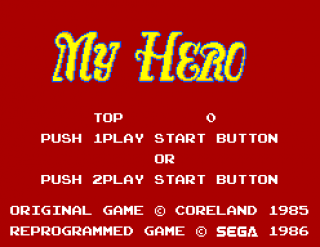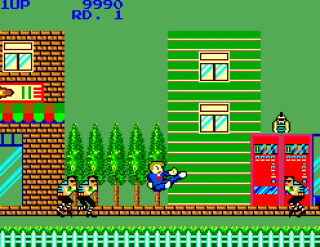Overview

My Hero is an early era side scrolling brawler developed by Coreland, a contractor to Sega of Japan's arcade division at the time. It is known by the name Seishun Scandal in Japan and first saw release for the arcades in 1985, with a Master System home console version arriving the following year.
Both versions allow for two players, however players must alternate turns and there are no opportunities for co-op play. The game is often regarded as a crude early entry into the 2D brawler genre and was a modest commercial success upon release. My Hero also enjoys the novelty of being available on the secondary Sega Card format for the Master System.
Story and Gameplay
 From the 1986 Sega Master System release
From the 1986 Sega Master System releaseA brief opening scene shows the hero and his girlfriend assaulted by oncoming bandits, resulting in a kidnapping for the girl and ample side-scrolling action motivation for the boy.
Gameplay consists of the player utilizing crouching and jumping kicks, along with a forward punch, to move the protagonist onward past enemies and obstacles. Henchmen will approach from both the left and right sides of the screen, often brandishing weapons. Individual stages scroll between cityscapes that feature large numbers of enemies, including bottle and knife throwers, to platform heavy segments with less opponents but a unique set obstacles including flinging bombs, charging pigs and fire pits.
At the end of each stage a boss battle occurs against the assailant under a sunset backdrop, 10 hit points apiece. After defeat the deviant will take the hero's girlfriend once again and the next stage begins. New stages introduce new foes, and there are three stages in total.
Soundtrack
The soundtrack for My Hero takes musical cues from Russian dance and traditional Hasidic Klezmer. It features a main theme that switches from C# minor to C# major every 8 measures. Additional themes are present during boss battles and story sequences.
Ported to the Sega Master System
My Hero holds a distinction as being one of the few titles released in the secondary Sega Card format, and it has the box art to prove it.
There are a number of differences between the original 1985 Arcade release and 1986 Sega Master System port, including:
 From the 1985 Arcade release
From the 1985 Arcade release- Defeated henchmen turn into small angels and fly away in the arcade release; on SMS they fly away using the same character model.
- Shops in the repeating city backdrop are more definable in the Arcade release, with some displaying text (Books, Games, Coffee/Snacks).
- The color of the sky has been changed from blue to green on SMS.
- Graphics are noticeably downgraded overall on the SMS.
There are currently no known plans by either Nintendo or Sega to make My Hero available as a downloadable title on the Wii Virtual Console at this time.
Log in to comment